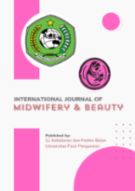EFFECTIVENESS OF THE IMPLEMENTATION OF THE CHILDBIRTH ENVIRONMENT WITH COMPLEMENTARY THERAPY (RELAXATION THERAPY, WARM COMPRESSES AND ENDORPHIN MASSAGES) AGAINST INTENSITY PAIN IN THE FIRST STAGE OF LABOR
Keywords:
Complementary Therapies, Pain ChildbirthAbstract
Childbirth is a process of spending the products of conception. Labor begins his existence, mucus blood and cervical dilation. There are two phases which Latin (opening 1-3 cm) and the active phase (4-10 cm opening). These phases will usually be accompanied by pain. Labor pain will be more severe if accompanied by fear, anxiety, tension and lack confidence, it is this which can aggravate the pain of labor. The application of the therapy delivery environment is expected to help mothers to penurunkan first stage of labor pain intensity active phase. The purpose of this study to determine the effectiveness of the application delivery environment with komplemeter therapy to decrease pain intensity first stage of labor active phase. The study design was a pre-experimental design with a comparison group static approach. The study population was all pregnant women who gave birth in PMB S Pasir Pengaraian, Rokan Hulu district in 2024, while the sample is multigravida mothers who gave birth in September 2023 to February 2024 some 16 maternal. Sampling technique used was purposive sampling. Data collection techniques using the Verbal Descriptor Scale. Data analysis using the Wilcoxon test. Research, the first stage of labor pain intensity in the active phase of the experimental group mostly feel the pain of labor at the level of moderate pain, by (50%) in the control group while the majority (50%) of respondents feel the pain of labor at the level of severe pain. Difference in pain intensity between maternal childbirth given application delivery environment with complementary therapies to mothers who were not given the application delivery environment with complementary therapies, P = 0.002 (p< 0.05).
Downloads
Downloads
Published
How to Cite
Issue
Section
License
Copyright (c) 2025 Siti Nurkhasanah, Elvira Junita

This work is licensed under a Creative Commons Attribution-NonCommercial-ShareAlike 4.0 International License.






